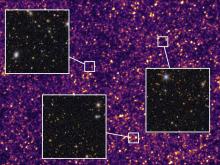UBC astronomers are part of the first international team to chart the unexplored outskirts of the Andromeda galaxy, a survey that has detected stars and giant structures that are almost certainly remnants of smaller galaxies gobbled up by Andromeda as part of its ongoing growth.
The survey--results of which are published today in Nature--is the broadest and deepest panoramic image of a galaxy ever made. The survey team includes UBC Physics and Astronomy professor Harvey Richer, and was led by National Research Council of Canada (NRC) astronomer Alan McConnachie.
"One of the difficulties is to identify the remnants of small galaxies that have been 'eaten' by the larger one," says Richer. "It's sort of like examining the droppings of a carnivore predator--we can see what the predator ate. In the case of a large galaxy the same is true. We see stars from the digested galaxy scattered into long tails and arcs around the larger galaxy. This is the Rosetta Stone of galaxy cannibalism."
Andromeda--our closest giant neighbour and visible to the naked eye from the Northern Hemisphere--is more than 2,000,000 light years from the Milky Way. The new survey spans a diameter equivalent to nearly 1,000,000 light years around the galaxy.
“That we are finding streams and structures over the entire survey area is a startling demonstration of the vast size of this ‘typical’ galaxy,” notes McConnachie, who works out of the NRC Herzberg Institute of Astrophysics. “Until a few years ago, no-one expected to find anything this far from the centre of a galaxy. But Andromeda is showing us that galaxies are much bigger than we originally thought.”
Galaxies are large collections of stars and other matter held together by gravity. A popular model of galaxy evolution holds that they grow through the accretion of smaller galaxies — a kind of galactic cannibalism. This ‘hierarchical model’ predicts that galaxies such as Andromeda should be surrounded by relics of the devoured galaxies--loosely bound stars at distances up to a hundred times the radius of the large galaxy’s central disk.
One way to test this idea is to find the leftovers from this process. But finding these faint structures is difficult, since it involves looking over an area hundreds of times larger than the main disk of the galaxy.
The results set the stage for a more detailed reconstruction of the formation of Andromeda, a process that appears to be continuing to this day.
The survey team includes NRC astronomers, university-based researchers from across Canada, as well as researchers in Australia, France, Germany, the UK and the USA.
The survey, which began in 2008 and continues through 2011, uses the Canada-France-Hawaii Telescope (CFHT), and CFHT’s MegaCam/MegaPrime digital camera, designed and built by the NRC Herzberg Institute of Astrophysics in Victoria, British Columbia.
Musqueam First Nation land acknowledegement
We honour xwməθkwəy̓ əm (Musqueam) on whose ancestral, unceded territory UBC Vancouver is situated. UBC Science is committed to building meaningful relationships with Indigenous peoples so we can advance Reconciliation and ensure traditional ways of knowing enrich our teaching and research.
Learn more: Musqueam First Nation
Faculty of Science
Office of the Dean, Earth Sciences Building2178–2207 Main Mall
Vancouver, BC Canada
V6T 1Z4


